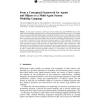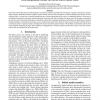24 search results - page 2 / 5 » Static BiLog: a Unifying Language for Spatial Structures |
SAS
2004
Springer
13 years 10 months ago
2004
Springer
Abstract. Programming language technology can contribute to the development and understanding of Systems Biology by providing formal calculi for specifying and analysing the dynami...
AAMAS
2004
Springer
13 years 4 months ago
2004
Springer
In this paper we propose a multi-agent system modeling language (MAS-ML) that extends UML (Unified Modeling Language) based on structural and dynamic properties presented in a conc...
ECOOP
2008
Springer
13 years 6 months ago
2008
Springer
Nominal and structural subtyping each have their own strengths and weaknesses. Nominal subtyping allows programmers to explicitly express design intent, and, when types are associa...
LREC
2010
13 years 6 months ago
2010
One of the essential functions of natural language is to talk about spatial relationships between objects. Linguistic constructs can express highly complex, relational structures ...
SEBD
2003
13 years 6 months ago
2003
The Ambient Logic is a modal logic proposed to describe the structural and computational properties of distributed and mobile computations. The static part of the Ambient Logic is,...


